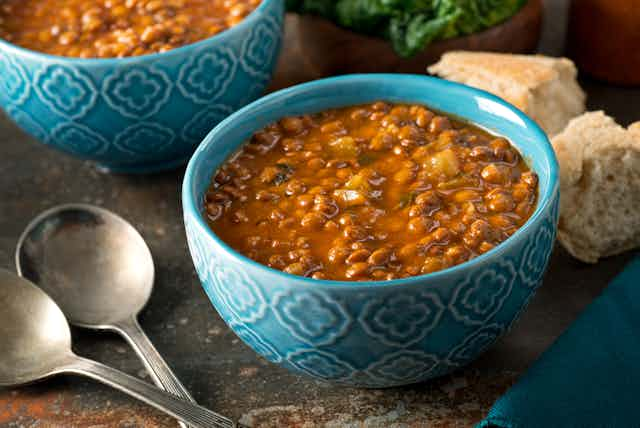The fascinating human gut bacterium Ruminococcus bromii is one of the ten most common bacterial species found in the colon.
This bacterium, first discovered discovered in 1972, plays a unique role in helping to breakdown resistant starch. These are some of the most commonly consumed carbohydrates in our diet, found in foods such as cereal grains, beans, lentils and some fruits (including plantains and green bananas). Without the hard work of R bromii, other cells and bacterial species in our guts might not have the energy they need to function.
There are many different Ruminococcus species. Each are very good at degrading different complex carbohydrates, mainly thanks to their specialised enzyme systems that allow them to extract energy from dietary fibres. For example, Ruminococcus flavefaciens, which is commonly found in cattle, goats and sheep, is particularly good at degrading cellulose (the main component of plant cell walls). In the human gut, Ruminococcus bromii is the species of bacterium that acts as this specialist starch degrader.
When R bromii breaks resistant starch down in the colon, it forms molecules called short-chain fatty acids. There are three main types of short-chain fatty acids: acetate, propionate and butyrate. These all have different roles when it comes to our health. Butyrate, for instance, is the main energy source for the cells lining the colon.
Each person has their own distinctive microbiome, which is made up of a few hundred different bacterial species. Your microbiome changes throughout your life, depending on several factors – including what medications you’re taking and the types of foods you eat. Some people will have higher levels of R bromii than others and this could have implications for their health.
A study carried out by myself and colleagues at the University of Aberdeen found that R bromii was most responsive when participants ate diets high in resistant starch. This response occurred rapidly, within a few days of the diet switch. The abundance of R bromii increased markedly and it was also quickly reversed by changing to another diet such as a low-carb diet.
A small number of the participants had very low levels of R bomii to begin with. Yet even when they were fed diets high in resistant starch, the population of R bromii in their gut remained low. These same volunteers also failed to completely break-down the resistant starch they ate, with much of the starch remaining in their stool samples.
This provided good evidence that Ruminococcus bromii plays a central role in the breakdown of resistant starch to by-products, such as glucose and acetate, that can be used by other bacteria. These by-products may then be used by other bacteria for growth. For example, acetate may used to form butyrate.

This may mean people who have low levels of R bromii can’t break down starch efficiently and will generate less beneficial short-chain fatty acids.
Carb lover
Ruminococcus bromii‘s remarkable ability to degrade resistant starch is determined by the cell’s enzyme systems. R bromii possesses around 27 enzymes that degrade carbohydrates.
R bromii arranges these enzymes into specialised structures called amylosomes on the surface of the cell. These structures chop up the complex resistant starch into simpler sugars (such as glucose) that the bacterium can then use for growth. R bromii also requires vitamins supplied by other species of gut bacteria in order to thrive.
The bacterium breaks down resistant starch through the process of fermentation. This process leads to the formation of other acids, such as acetate and formate. This bacterium also forms alcohol (ethanol). “Bromii” actually translates to “god of alcohol”, referring to its alcohol-producing abilities. The acids produced through the fermentation process can be used to feed other species of bacteria.
For example, formate can be used by the bacterial species Blautia to form acetate. This is in turn used to fuel the bacterial species Faecalibacterium, which forms butyrate. Butyrate not only provides energy for the cells in the lining of the colon, it also reduces colonisation of pathogens in our gut – helping support our immune system and reduce inflammation.
While we don’t think a lot about what happens to the starchy carbs we eat, you can rest assured that Ruminococcus bromii is hard at work in your gut, using these foods to nourish other important gut bacteria through the acids it forms. These are then used to form a range of other by-products (such as butyrate) which helps fuel a healthy colon and even prevents diseases such as cancer.

This article is part of Meet Your Gut Microbes, a series about the rich constellation of bacteria, viruses, archaea and fungi that live in people’s digestive tracts. Scientists are increasingly realising their importance in shaping our health – both physical and mental. Each week we will look at a different microbe and bring you the most up-to-date research on them.

